HRM4005: Communication and Collaboration Essay - [University Name]
VerifiedAdded on 2022/11/25
|11
|3971
|277
Essay
AI Summary
This essay explores communication and collaboration within a professional environment, specifically focusing on the Special Needs Alliance and its role in supporting children and adults with multiple learning disabilities. The essay begins by defining multi-agency working and its positive impact on service user and staff well-being, emphasizing the importance of trust, shared responsibility, and effective communication. It then delves into the significance of collaborative working, highlighting how teamwork enhances creativity, problem-solving, and engagement. The essay also examines the role of care workers in supporting service users and their families through effective communication and collaboration, addressing needs such as accessing health services and providing emotional support. Finally, the essay reflects on a critical incident, demonstrating the ability to transfer good practices to others within a work setting, offering insights into fostering a positive and supportive environment for individuals with profound and multiple learning disabilities. The essay emphasizes the importance of accountability, supportive colleagues, positive attitudes, active listening, and continuous learning in fostering effective teamwork and delivering quality care.
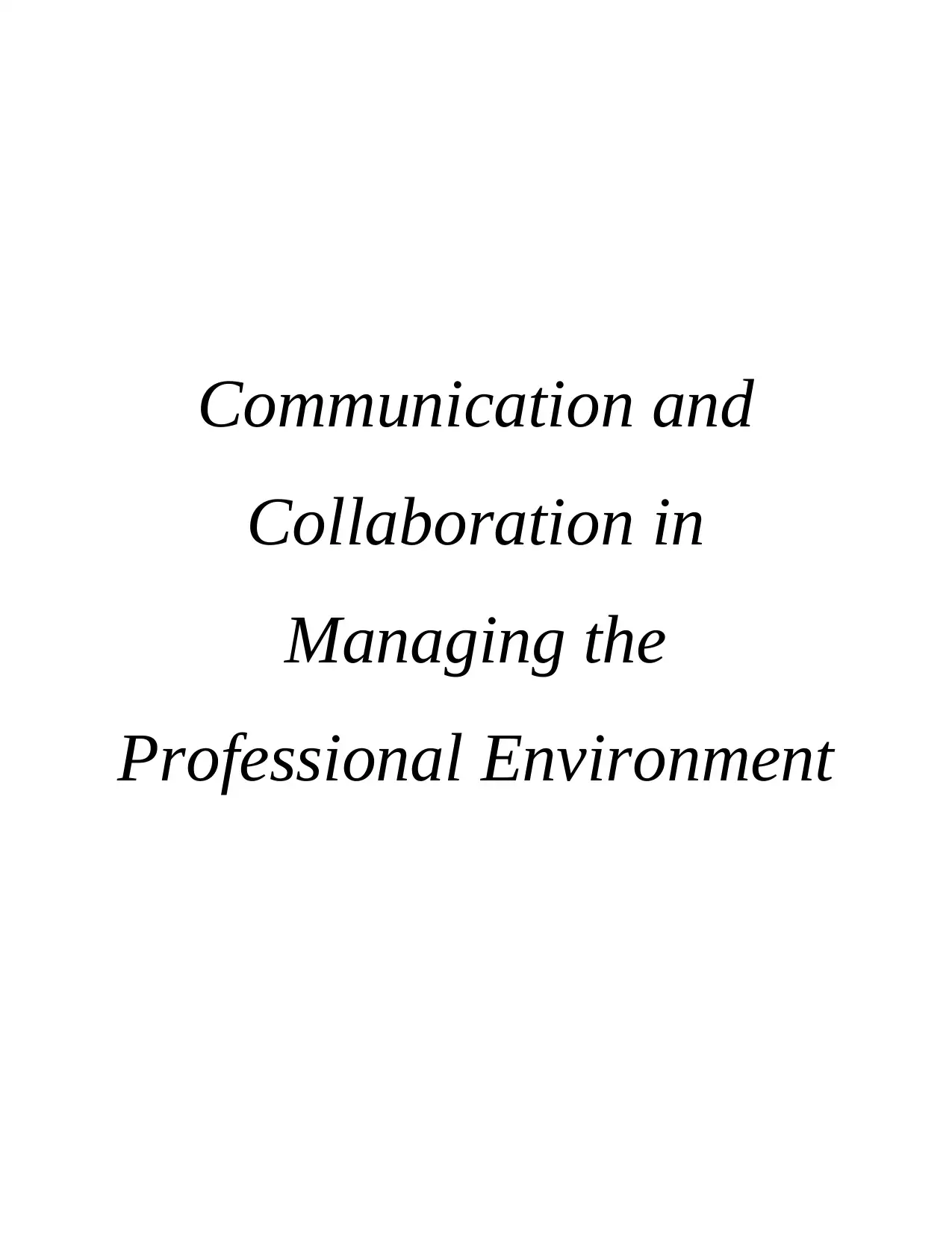
Communication and
Collaboration in
Managing the
Professional Environment
Collaboration in
Managing the
Professional Environment
Paraphrase This Document
Need a fresh take? Get an instant paraphrase of this document with our AI Paraphraser
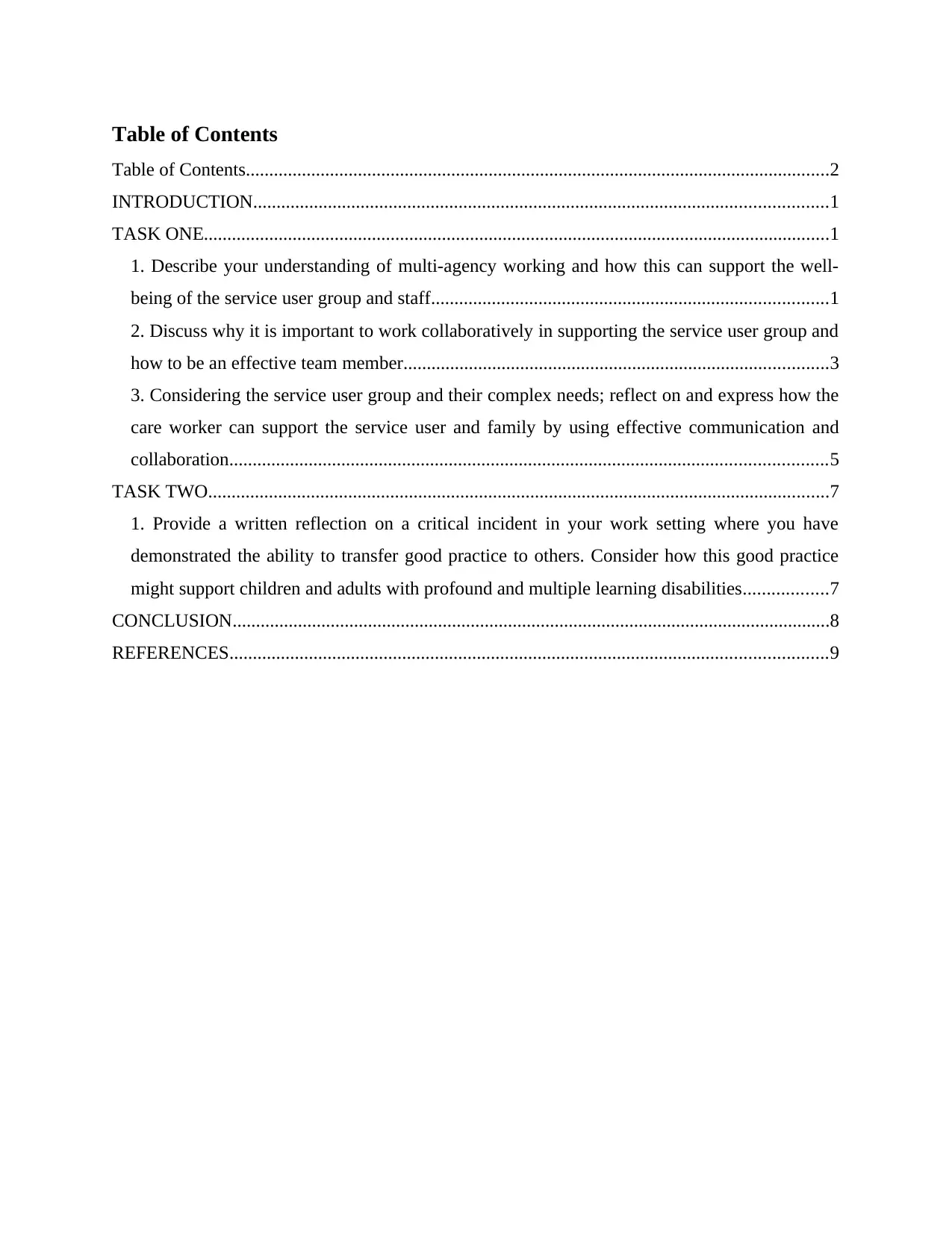
Table of Contents
Table of Contents.............................................................................................................................2
INTRODUCTION...........................................................................................................................1
TASK ONE......................................................................................................................................1
1. Describe your understanding of multi-agency working and how this can support the well-
being of the service user group and staff.....................................................................................1
2. Discuss why it is important to work collaboratively in supporting the service user group and
how to be an effective team member...........................................................................................3
3. Considering the service user group and their complex needs; reflect on and express how the
care worker can support the service user and family by using effective communication and
collaboration................................................................................................................................5
TASK TWO.....................................................................................................................................7
1. Provide a written reflection on a critical incident in your work setting where you have
demonstrated the ability to transfer good practice to others. Consider how this good practice
might support children and adults with profound and multiple learning disabilities..................7
CONCLUSION................................................................................................................................8
REFERENCES................................................................................................................................9
Table of Contents.............................................................................................................................2
INTRODUCTION...........................................................................................................................1
TASK ONE......................................................................................................................................1
1. Describe your understanding of multi-agency working and how this can support the well-
being of the service user group and staff.....................................................................................1
2. Discuss why it is important to work collaboratively in supporting the service user group and
how to be an effective team member...........................................................................................3
3. Considering the service user group and their complex needs; reflect on and express how the
care worker can support the service user and family by using effective communication and
collaboration................................................................................................................................5
TASK TWO.....................................................................................................................................7
1. Provide a written reflection on a critical incident in your work setting where you have
demonstrated the ability to transfer good practice to others. Consider how this good practice
might support children and adults with profound and multiple learning disabilities..................7
CONCLUSION................................................................................................................................8
REFERENCES................................................................................................................................9
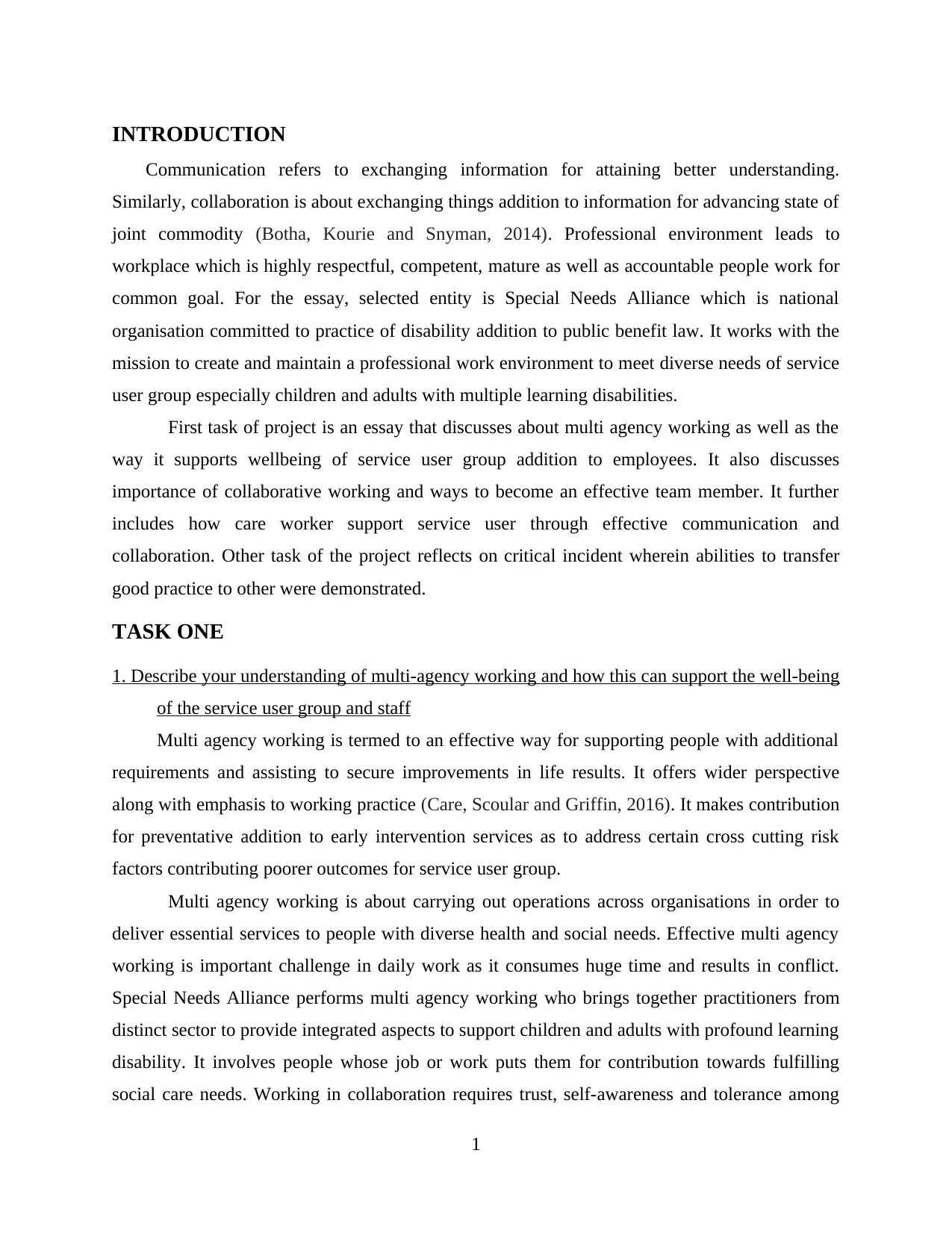
INTRODUCTION
Communication refers to exchanging information for attaining better understanding.
Similarly, collaboration is about exchanging things addition to information for advancing state of
joint commodity (Botha, Kourie and Snyman, 2014). Professional environment leads to
workplace which is highly respectful, competent, mature as well as accountable people work for
common goal. For the essay, selected entity is Special Needs Alliance which is national
organisation committed to practice of disability addition to public benefit law. It works with the
mission to create and maintain a professional work environment to meet diverse needs of service
user group especially children and adults with multiple learning disabilities.
First task of project is an essay that discusses about multi agency working as well as the
way it supports wellbeing of service user group addition to employees. It also discusses
importance of collaborative working and ways to become an effective team member. It further
includes how care worker support service user through effective communication and
collaboration. Other task of the project reflects on critical incident wherein abilities to transfer
good practice to other were demonstrated.
TASK ONE
1. Describe your understanding of multi-agency working and how this can support the well-being
of the service user group and staff
Multi agency working is termed to an effective way for supporting people with additional
requirements and assisting to secure improvements in life results. It offers wider perspective
along with emphasis to working practice (Care, Scoular and Griffin, 2016). It makes contribution
for preventative addition to early intervention services as to address certain cross cutting risk
factors contributing poorer outcomes for service user group.
Multi agency working is about carrying out operations across organisations in order to
deliver essential services to people with diverse health and social needs. Effective multi agency
working is important challenge in daily work as it consumes huge time and results in conflict.
Special Needs Alliance performs multi agency working who brings together practitioners from
distinct sector to provide integrated aspects to support children and adults with profound learning
disability. It involves people whose job or work puts them for contribution towards fulfilling
social care needs. Working in collaboration requires trust, self-awareness and tolerance among
1
Communication refers to exchanging information for attaining better understanding.
Similarly, collaboration is about exchanging things addition to information for advancing state of
joint commodity (Botha, Kourie and Snyman, 2014). Professional environment leads to
workplace which is highly respectful, competent, mature as well as accountable people work for
common goal. For the essay, selected entity is Special Needs Alliance which is national
organisation committed to practice of disability addition to public benefit law. It works with the
mission to create and maintain a professional work environment to meet diverse needs of service
user group especially children and adults with multiple learning disabilities.
First task of project is an essay that discusses about multi agency working as well as the
way it supports wellbeing of service user group addition to employees. It also discusses
importance of collaborative working and ways to become an effective team member. It further
includes how care worker support service user through effective communication and
collaboration. Other task of the project reflects on critical incident wherein abilities to transfer
good practice to other were demonstrated.
TASK ONE
1. Describe your understanding of multi-agency working and how this can support the well-being
of the service user group and staff
Multi agency working is termed to an effective way for supporting people with additional
requirements and assisting to secure improvements in life results. It offers wider perspective
along with emphasis to working practice (Care, Scoular and Griffin, 2016). It makes contribution
for preventative addition to early intervention services as to address certain cross cutting risk
factors contributing poorer outcomes for service user group.
Multi agency working is about carrying out operations across organisations in order to
deliver essential services to people with diverse health and social needs. Effective multi agency
working is important challenge in daily work as it consumes huge time and results in conflict.
Special Needs Alliance performs multi agency working who brings together practitioners from
distinct sector to provide integrated aspects to support children and adults with profound learning
disability. It involves people whose job or work puts them for contribution towards fulfilling
social care needs. Working in collaboration requires trust, self-awareness and tolerance among
1
⊘ This is a preview!⊘
Do you want full access?
Subscribe today to unlock all pages.

Trusted by 1+ million students worldwide
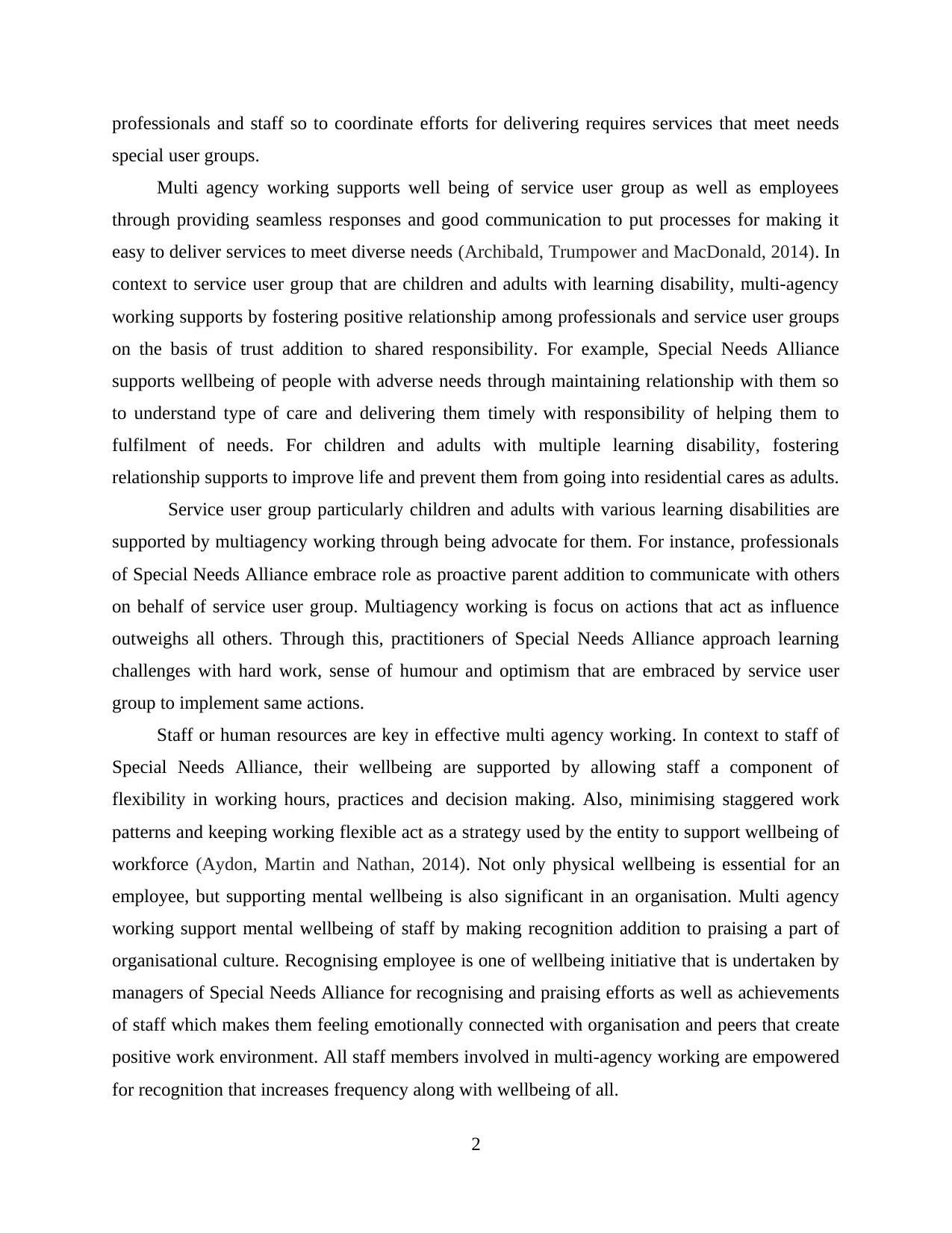
professionals and staff so to coordinate efforts for delivering requires services that meet needs
special user groups.
Multi agency working supports well being of service user group as well as employees
through providing seamless responses and good communication to put processes for making it
easy to deliver services to meet diverse needs (Archibald, Trumpower and MacDonald, 2014). In
context to service user group that are children and adults with learning disability, multi-agency
working supports by fostering positive relationship among professionals and service user groups
on the basis of trust addition to shared responsibility. For example, Special Needs Alliance
supports wellbeing of people with adverse needs through maintaining relationship with them so
to understand type of care and delivering them timely with responsibility of helping them to
fulfilment of needs. For children and adults with multiple learning disability, fostering
relationship supports to improve life and prevent them from going into residential cares as adults.
Service user group particularly children and adults with various learning disabilities are
supported by multiagency working through being advocate for them. For instance, professionals
of Special Needs Alliance embrace role as proactive parent addition to communicate with others
on behalf of service user group. Multiagency working is focus on actions that act as influence
outweighs all others. Through this, practitioners of Special Needs Alliance approach learning
challenges with hard work, sense of humour and optimism that are embraced by service user
group to implement same actions.
Staff or human resources are key in effective multi agency working. In context to staff of
Special Needs Alliance, their wellbeing are supported by allowing staff a component of
flexibility in working hours, practices and decision making. Also, minimising staggered work
patterns and keeping working flexible act as a strategy used by the entity to support wellbeing of
workforce (Aydon, Martin and Nathan, 2014). Not only physical wellbeing is essential for an
employee, but supporting mental wellbeing is also significant in an organisation. Multi agency
working support mental wellbeing of staff by making recognition addition to praising a part of
organisational culture. Recognising employee is one of wellbeing initiative that is undertaken by
managers of Special Needs Alliance for recognising and praising efforts as well as achievements
of staff which makes them feeling emotionally connected with organisation and peers that create
positive work environment. All staff members involved in multi-agency working are empowered
for recognition that increases frequency along with wellbeing of all.
2
special user groups.
Multi agency working supports well being of service user group as well as employees
through providing seamless responses and good communication to put processes for making it
easy to deliver services to meet diverse needs (Archibald, Trumpower and MacDonald, 2014). In
context to service user group that are children and adults with learning disability, multi-agency
working supports by fostering positive relationship among professionals and service user groups
on the basis of trust addition to shared responsibility. For example, Special Needs Alliance
supports wellbeing of people with adverse needs through maintaining relationship with them so
to understand type of care and delivering them timely with responsibility of helping them to
fulfilment of needs. For children and adults with multiple learning disability, fostering
relationship supports to improve life and prevent them from going into residential cares as adults.
Service user group particularly children and adults with various learning disabilities are
supported by multiagency working through being advocate for them. For instance, professionals
of Special Needs Alliance embrace role as proactive parent addition to communicate with others
on behalf of service user group. Multiagency working is focus on actions that act as influence
outweighs all others. Through this, practitioners of Special Needs Alliance approach learning
challenges with hard work, sense of humour and optimism that are embraced by service user
group to implement same actions.
Staff or human resources are key in effective multi agency working. In context to staff of
Special Needs Alliance, their wellbeing are supported by allowing staff a component of
flexibility in working hours, practices and decision making. Also, minimising staggered work
patterns and keeping working flexible act as a strategy used by the entity to support wellbeing of
workforce (Aydon, Martin and Nathan, 2014). Not only physical wellbeing is essential for an
employee, but supporting mental wellbeing is also significant in an organisation. Multi agency
working support mental wellbeing of staff by making recognition addition to praising a part of
organisational culture. Recognising employee is one of wellbeing initiative that is undertaken by
managers of Special Needs Alliance for recognising and praising efforts as well as achievements
of staff which makes them feeling emotionally connected with organisation and peers that create
positive work environment. All staff members involved in multi-agency working are empowered
for recognition that increases frequency along with wellbeing of all.
2
Paraphrase This Document
Need a fresh take? Get an instant paraphrase of this document with our AI Paraphraser
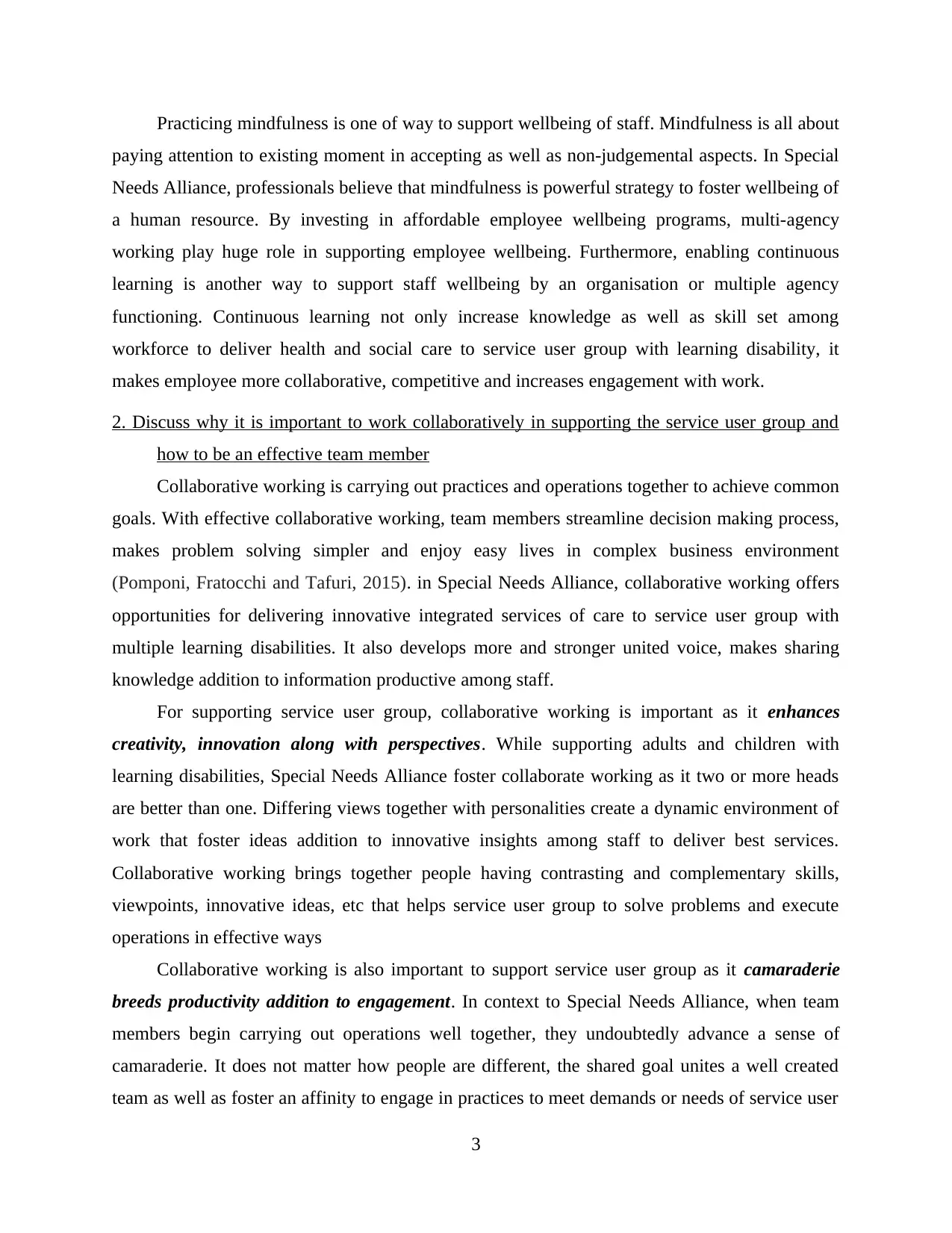
Practicing mindfulness is one of way to support wellbeing of staff. Mindfulness is all about
paying attention to existing moment in accepting as well as non-judgemental aspects. In Special
Needs Alliance, professionals believe that mindfulness is powerful strategy to foster wellbeing of
a human resource. By investing in affordable employee wellbeing programs, multi-agency
working play huge role in supporting employee wellbeing. Furthermore, enabling continuous
learning is another way to support staff wellbeing by an organisation or multiple agency
functioning. Continuous learning not only increase knowledge as well as skill set among
workforce to deliver health and social care to service user group with learning disability, it
makes employee more collaborative, competitive and increases engagement with work.
2. Discuss why it is important to work collaboratively in supporting the service user group and
how to be an effective team member
Collaborative working is carrying out practices and operations together to achieve common
goals. With effective collaborative working, team members streamline decision making process,
makes problem solving simpler and enjoy easy lives in complex business environment
(Pomponi, Fratocchi and Tafuri, 2015). in Special Needs Alliance, collaborative working offers
opportunities for delivering innovative integrated services of care to service user group with
multiple learning disabilities. It also develops more and stronger united voice, makes sharing
knowledge addition to information productive among staff.
For supporting service user group, collaborative working is important as it enhances
creativity, innovation along with perspectives. While supporting adults and children with
learning disabilities, Special Needs Alliance foster collaborate working as it two or more heads
are better than one. Differing views together with personalities create a dynamic environment of
work that foster ideas addition to innovative insights among staff to deliver best services.
Collaborative working brings together people having contrasting and complementary skills,
viewpoints, innovative ideas, etc that helps service user group to solve problems and execute
operations in effective ways
Collaborative working is also important to support service user group as it camaraderie
breeds productivity addition to engagement. In context to Special Needs Alliance, when team
members begin carrying out operations well together, they undoubtedly advance a sense of
camaraderie. It does not matter how people are different, the shared goal unites a well created
team as well as foster an affinity to engage in practices to meet demands or needs of service user
3
paying attention to existing moment in accepting as well as non-judgemental aspects. In Special
Needs Alliance, professionals believe that mindfulness is powerful strategy to foster wellbeing of
a human resource. By investing in affordable employee wellbeing programs, multi-agency
working play huge role in supporting employee wellbeing. Furthermore, enabling continuous
learning is another way to support staff wellbeing by an organisation or multiple agency
functioning. Continuous learning not only increase knowledge as well as skill set among
workforce to deliver health and social care to service user group with learning disability, it
makes employee more collaborative, competitive and increases engagement with work.
2. Discuss why it is important to work collaboratively in supporting the service user group and
how to be an effective team member
Collaborative working is carrying out practices and operations together to achieve common
goals. With effective collaborative working, team members streamline decision making process,
makes problem solving simpler and enjoy easy lives in complex business environment
(Pomponi, Fratocchi and Tafuri, 2015). in Special Needs Alliance, collaborative working offers
opportunities for delivering innovative integrated services of care to service user group with
multiple learning disabilities. It also develops more and stronger united voice, makes sharing
knowledge addition to information productive among staff.
For supporting service user group, collaborative working is important as it enhances
creativity, innovation along with perspectives. While supporting adults and children with
learning disabilities, Special Needs Alliance foster collaborate working as it two or more heads
are better than one. Differing views together with personalities create a dynamic environment of
work that foster ideas addition to innovative insights among staff to deliver best services.
Collaborative working brings together people having contrasting and complementary skills,
viewpoints, innovative ideas, etc that helps service user group to solve problems and execute
operations in effective ways
Collaborative working is also important to support service user group as it camaraderie
breeds productivity addition to engagement. In context to Special Needs Alliance, when team
members begin carrying out operations well together, they undoubtedly advance a sense of
camaraderie. It does not matter how people are different, the shared goal unites a well created
team as well as foster an affinity to engage in practices to meet demands or needs of service user
3
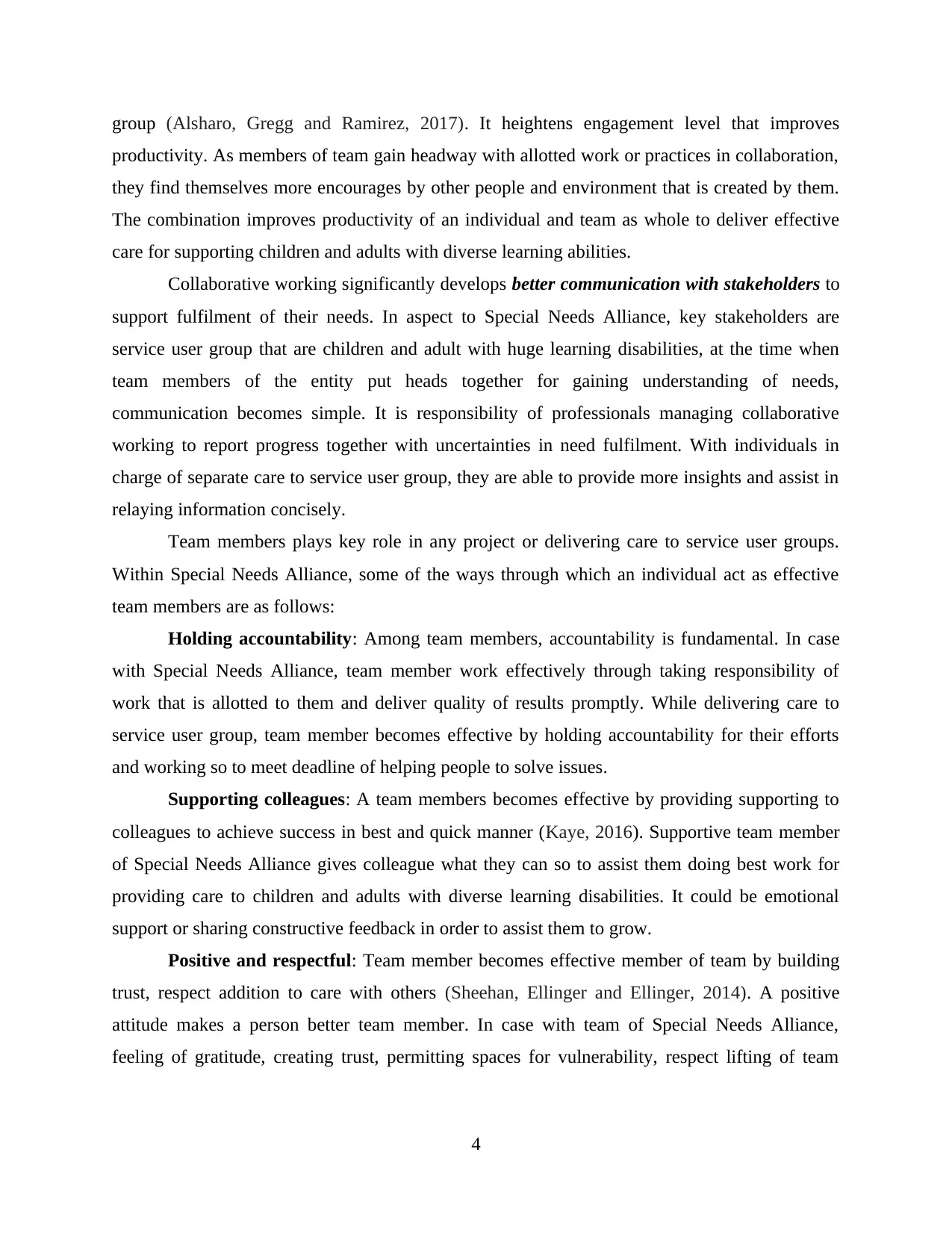
group (Alsharo, Gregg and Ramirez, 2017). It heightens engagement level that improves
productivity. As members of team gain headway with allotted work or practices in collaboration,
they find themselves more encourages by other people and environment that is created by them.
The combination improves productivity of an individual and team as whole to deliver effective
care for supporting children and adults with diverse learning abilities.
Collaborative working significantly develops better communication with stakeholders to
support fulfilment of their needs. In aspect to Special Needs Alliance, key stakeholders are
service user group that are children and adult with huge learning disabilities, at the time when
team members of the entity put heads together for gaining understanding of needs,
communication becomes simple. It is responsibility of professionals managing collaborative
working to report progress together with uncertainties in need fulfilment. With individuals in
charge of separate care to service user group, they are able to provide more insights and assist in
relaying information concisely.
Team members plays key role in any project or delivering care to service user groups.
Within Special Needs Alliance, some of the ways through which an individual act as effective
team members are as follows:
Holding accountability: Among team members, accountability is fundamental. In case
with Special Needs Alliance, team member work effectively through taking responsibility of
work that is allotted to them and deliver quality of results promptly. While delivering care to
service user group, team member becomes effective by holding accountability for their efforts
and working so to meet deadline of helping people to solve issues.
Supporting colleagues: A team members becomes effective by providing supporting to
colleagues to achieve success in best and quick manner (Kaye, 2016). Supportive team member
of Special Needs Alliance gives colleague what they can so to assist them doing best work for
providing care to children and adults with diverse learning disabilities. It could be emotional
support or sharing constructive feedback in order to assist them to grow.
Positive and respectful: Team member becomes effective member of team by building
trust, respect addition to care with others (Sheehan, Ellinger and Ellinger, 2014). A positive
attitude makes a person better team member. In case with team of Special Needs Alliance,
feeling of gratitude, creating trust, permitting spaces for vulnerability, respect lifting of team
4
productivity. As members of team gain headway with allotted work or practices in collaboration,
they find themselves more encourages by other people and environment that is created by them.
The combination improves productivity of an individual and team as whole to deliver effective
care for supporting children and adults with diverse learning abilities.
Collaborative working significantly develops better communication with stakeholders to
support fulfilment of their needs. In aspect to Special Needs Alliance, key stakeholders are
service user group that are children and adult with huge learning disabilities, at the time when
team members of the entity put heads together for gaining understanding of needs,
communication becomes simple. It is responsibility of professionals managing collaborative
working to report progress together with uncertainties in need fulfilment. With individuals in
charge of separate care to service user group, they are able to provide more insights and assist in
relaying information concisely.
Team members plays key role in any project or delivering care to service user groups.
Within Special Needs Alliance, some of the ways through which an individual act as effective
team members are as follows:
Holding accountability: Among team members, accountability is fundamental. In case
with Special Needs Alliance, team member work effectively through taking responsibility of
work that is allotted to them and deliver quality of results promptly. While delivering care to
service user group, team member becomes effective by holding accountability for their efforts
and working so to meet deadline of helping people to solve issues.
Supporting colleagues: A team members becomes effective by providing supporting to
colleagues to achieve success in best and quick manner (Kaye, 2016). Supportive team member
of Special Needs Alliance gives colleague what they can so to assist them doing best work for
providing care to children and adults with diverse learning disabilities. It could be emotional
support or sharing constructive feedback in order to assist them to grow.
Positive and respectful: Team member becomes effective member of team by building
trust, respect addition to care with others (Sheehan, Ellinger and Ellinger, 2014). A positive
attitude makes a person better team member. In case with team of Special Needs Alliance,
feeling of gratitude, creating trust, permitting spaces for vulnerability, respect lifting of team
4
⊘ This is a preview!⊘
Do you want full access?
Subscribe today to unlock all pages.

Trusted by 1+ million students worldwide
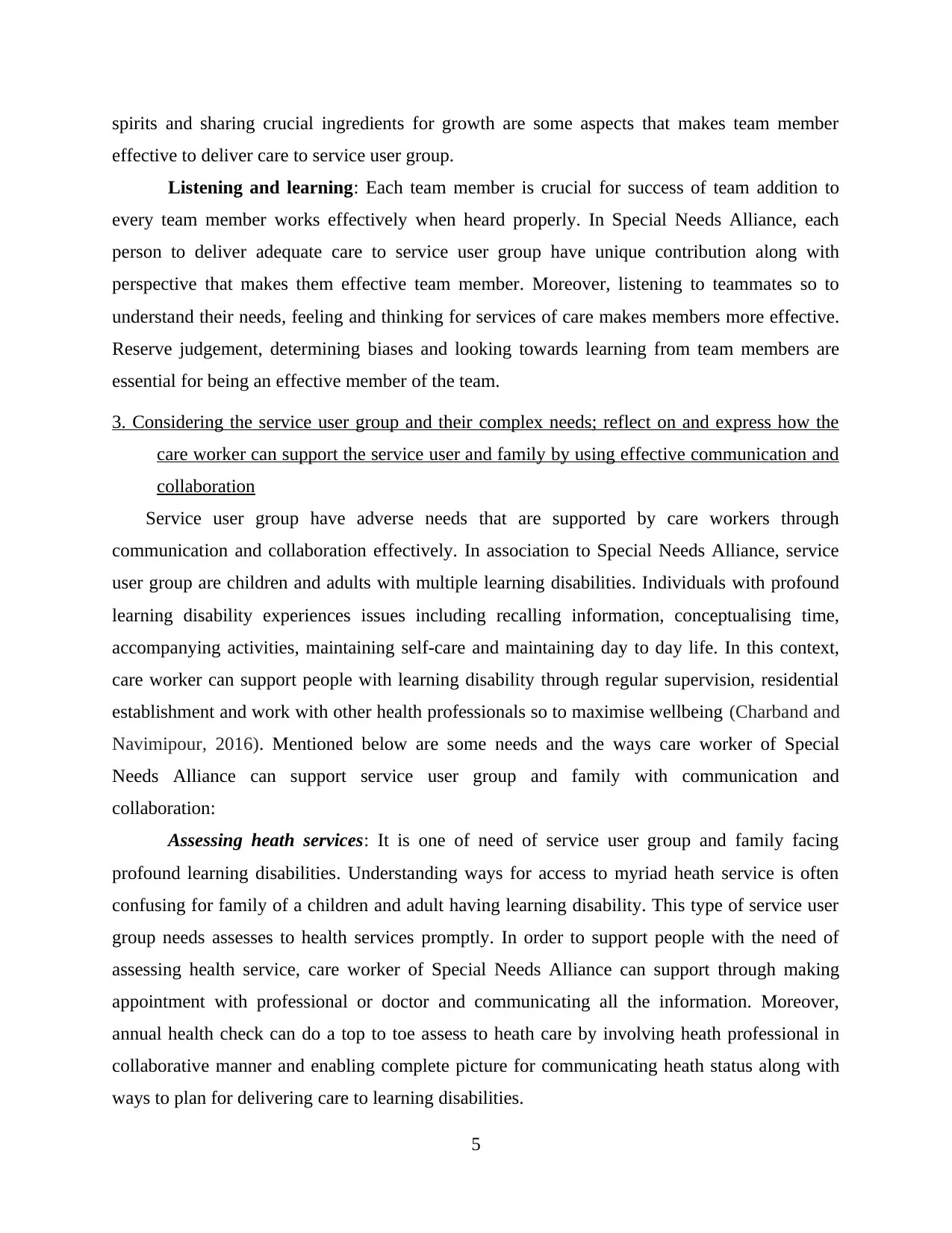
spirits and sharing crucial ingredients for growth are some aspects that makes team member
effective to deliver care to service user group.
Listening and learning: Each team member is crucial for success of team addition to
every team member works effectively when heard properly. In Special Needs Alliance, each
person to deliver adequate care to service user group have unique contribution along with
perspective that makes them effective team member. Moreover, listening to teammates so to
understand their needs, feeling and thinking for services of care makes members more effective.
Reserve judgement, determining biases and looking towards learning from team members are
essential for being an effective member of the team.
3. Considering the service user group and their complex needs; reflect on and express how the
care worker can support the service user and family by using effective communication and
collaboration
Service user group have adverse needs that are supported by care workers through
communication and collaboration effectively. In association to Special Needs Alliance, service
user group are children and adults with multiple learning disabilities. Individuals with profound
learning disability experiences issues including recalling information, conceptualising time,
accompanying activities, maintaining self-care and maintaining day to day life. In this context,
care worker can support people with learning disability through regular supervision, residential
establishment and work with other health professionals so to maximise wellbeing (Charband and
Navimipour, 2016). Mentioned below are some needs and the ways care worker of Special
Needs Alliance can support service user group and family with communication and
collaboration:
Assessing heath services: It is one of need of service user group and family facing
profound learning disabilities. Understanding ways for access to myriad heath service is often
confusing for family of a children and adult having learning disability. This type of service user
group needs assesses to health services promptly. In order to support people with the need of
assessing health service, care worker of Special Needs Alliance can support through making
appointment with professional or doctor and communicating all the information. Moreover,
annual health check can do a top to toe assess to heath care by involving heath professional in
collaborative manner and enabling complete picture for communicating heath status along with
ways to plan for delivering care to learning disabilities.
5
effective to deliver care to service user group.
Listening and learning: Each team member is crucial for success of team addition to
every team member works effectively when heard properly. In Special Needs Alliance, each
person to deliver adequate care to service user group have unique contribution along with
perspective that makes them effective team member. Moreover, listening to teammates so to
understand their needs, feeling and thinking for services of care makes members more effective.
Reserve judgement, determining biases and looking towards learning from team members are
essential for being an effective member of the team.
3. Considering the service user group and their complex needs; reflect on and express how the
care worker can support the service user and family by using effective communication and
collaboration
Service user group have adverse needs that are supported by care workers through
communication and collaboration effectively. In association to Special Needs Alliance, service
user group are children and adults with multiple learning disabilities. Individuals with profound
learning disability experiences issues including recalling information, conceptualising time,
accompanying activities, maintaining self-care and maintaining day to day life. In this context,
care worker can support people with learning disability through regular supervision, residential
establishment and work with other health professionals so to maximise wellbeing (Charband and
Navimipour, 2016). Mentioned below are some needs and the ways care worker of Special
Needs Alliance can support service user group and family with communication and
collaboration:
Assessing heath services: It is one of need of service user group and family facing
profound learning disabilities. Understanding ways for access to myriad heath service is often
confusing for family of a children and adult having learning disability. This type of service user
group needs assesses to health services promptly. In order to support people with the need of
assessing health service, care worker of Special Needs Alliance can support through making
appointment with professional or doctor and communicating all the information. Moreover,
annual health check can do a top to toe assess to heath care by involving heath professional in
collaborative manner and enabling complete picture for communicating heath status along with
ways to plan for delivering care to learning disabilities.
5
Paraphrase This Document
Need a fresh take? Get an instant paraphrase of this document with our AI Paraphraser
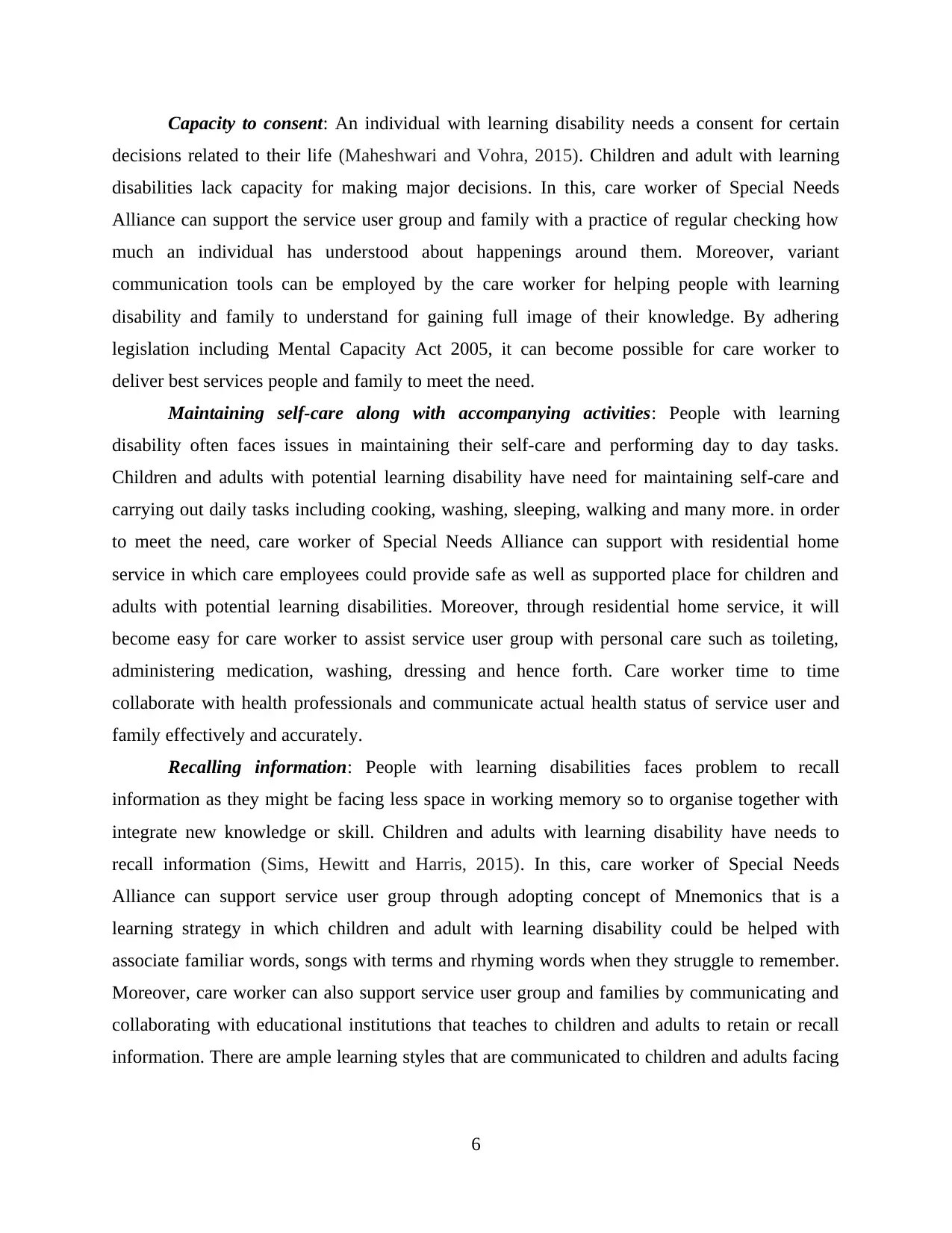
Capacity to consent: An individual with learning disability needs a consent for certain
decisions related to their life (Maheshwari and Vohra, 2015). Children and adult with learning
disabilities lack capacity for making major decisions. In this, care worker of Special Needs
Alliance can support the service user group and family with a practice of regular checking how
much an individual has understood about happenings around them. Moreover, variant
communication tools can be employed by the care worker for helping people with learning
disability and family to understand for gaining full image of their knowledge. By adhering
legislation including Mental Capacity Act 2005, it can become possible for care worker to
deliver best services people and family to meet the need.
Maintaining self-care along with accompanying activities: People with learning
disability often faces issues in maintaining their self-care and performing day to day tasks.
Children and adults with potential learning disability have need for maintaining self-care and
carrying out daily tasks including cooking, washing, sleeping, walking and many more. in order
to meet the need, care worker of Special Needs Alliance can support with residential home
service in which care employees could provide safe as well as supported place for children and
adults with potential learning disabilities. Moreover, through residential home service, it will
become easy for care worker to assist service user group with personal care such as toileting,
administering medication, washing, dressing and hence forth. Care worker time to time
collaborate with health professionals and communicate actual health status of service user and
family effectively and accurately.
Recalling information: People with learning disabilities faces problem to recall
information as they might be facing less space in working memory so to organise together with
integrate new knowledge or skill. Children and adults with learning disability have needs to
recall information (Sims, Hewitt and Harris, 2015). In this, care worker of Special Needs
Alliance can support service user group through adopting concept of Mnemonics that is a
learning strategy in which children and adult with learning disability could be helped with
associate familiar words, songs with terms and rhyming words when they struggle to remember.
Moreover, care worker can also support service user group and families by communicating and
collaborating with educational institutions that teaches to children and adults to retain or recall
information. There are ample learning styles that are communicated to children and adults facing
6
decisions related to their life (Maheshwari and Vohra, 2015). Children and adult with learning
disabilities lack capacity for making major decisions. In this, care worker of Special Needs
Alliance can support the service user group and family with a practice of regular checking how
much an individual has understood about happenings around them. Moreover, variant
communication tools can be employed by the care worker for helping people with learning
disability and family to understand for gaining full image of their knowledge. By adhering
legislation including Mental Capacity Act 2005, it can become possible for care worker to
deliver best services people and family to meet the need.
Maintaining self-care along with accompanying activities: People with learning
disability often faces issues in maintaining their self-care and performing day to day tasks.
Children and adults with potential learning disability have need for maintaining self-care and
carrying out daily tasks including cooking, washing, sleeping, walking and many more. in order
to meet the need, care worker of Special Needs Alliance can support with residential home
service in which care employees could provide safe as well as supported place for children and
adults with potential learning disabilities. Moreover, through residential home service, it will
become easy for care worker to assist service user group with personal care such as toileting,
administering medication, washing, dressing and hence forth. Care worker time to time
collaborate with health professionals and communicate actual health status of service user and
family effectively and accurately.
Recalling information: People with learning disabilities faces problem to recall
information as they might be facing less space in working memory so to organise together with
integrate new knowledge or skill. Children and adults with learning disability have needs to
recall information (Sims, Hewitt and Harris, 2015). In this, care worker of Special Needs
Alliance can support service user group through adopting concept of Mnemonics that is a
learning strategy in which children and adult with learning disability could be helped with
associate familiar words, songs with terms and rhyming words when they struggle to remember.
Moreover, care worker can also support service user group and families by communicating and
collaborating with educational institutions that teaches to children and adults to retain or recall
information. There are ample learning styles that are communicated to children and adults facing
6
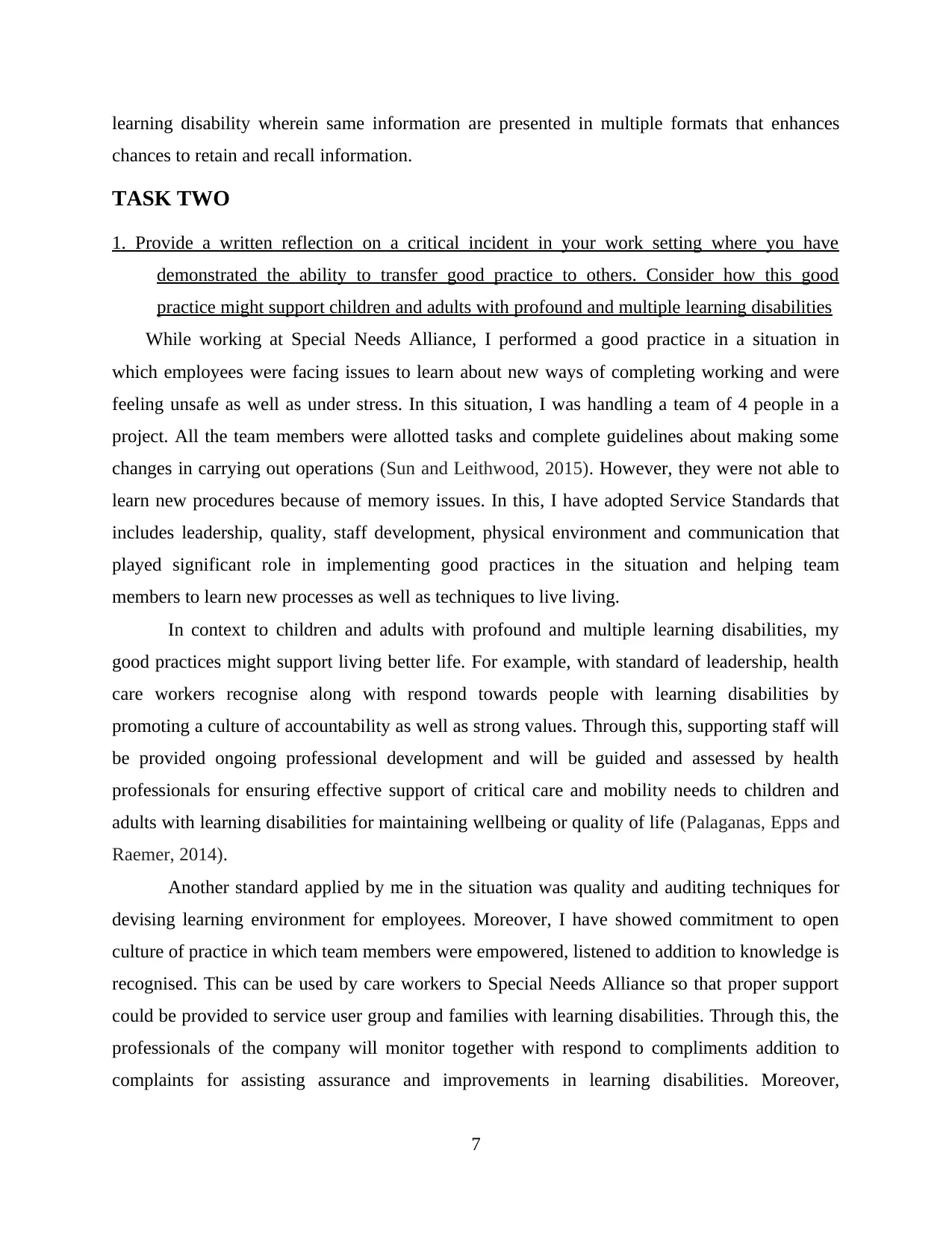
learning disability wherein same information are presented in multiple formats that enhances
chances to retain and recall information.
TASK TWO
1. Provide a written reflection on a critical incident in your work setting where you have
demonstrated the ability to transfer good practice to others. Consider how this good
practice might support children and adults with profound and multiple learning disabilities
While working at Special Needs Alliance, I performed a good practice in a situation in
which employees were facing issues to learn about new ways of completing working and were
feeling unsafe as well as under stress. In this situation, I was handling a team of 4 people in a
project. All the team members were allotted tasks and complete guidelines about making some
changes in carrying out operations (Sun and Leithwood, 2015). However, they were not able to
learn new procedures because of memory issues. In this, I have adopted Service Standards that
includes leadership, quality, staff development, physical environment and communication that
played significant role in implementing good practices in the situation and helping team
members to learn new processes as well as techniques to live living.
In context to children and adults with profound and multiple learning disabilities, my
good practices might support living better life. For example, with standard of leadership, health
care workers recognise along with respond towards people with learning disabilities by
promoting a culture of accountability as well as strong values. Through this, supporting staff will
be provided ongoing professional development and will be guided and assessed by health
professionals for ensuring effective support of critical care and mobility needs to children and
adults with learning disabilities for maintaining wellbeing or quality of life (Palaganas, Epps and
Raemer, 2014).
Another standard applied by me in the situation was quality and auditing techniques for
devising learning environment for employees. Moreover, I have showed commitment to open
culture of practice in which team members were empowered, listened to addition to knowledge is
recognised. This can be used by care workers to Special Needs Alliance so that proper support
could be provided to service user group and families with learning disabilities. Through this, the
professionals of the company will monitor together with respond to compliments addition to
complaints for assisting assurance and improvements in learning disabilities. Moreover,
7
chances to retain and recall information.
TASK TWO
1. Provide a written reflection on a critical incident in your work setting where you have
demonstrated the ability to transfer good practice to others. Consider how this good
practice might support children and adults with profound and multiple learning disabilities
While working at Special Needs Alliance, I performed a good practice in a situation in
which employees were facing issues to learn about new ways of completing working and were
feeling unsafe as well as under stress. In this situation, I was handling a team of 4 people in a
project. All the team members were allotted tasks and complete guidelines about making some
changes in carrying out operations (Sun and Leithwood, 2015). However, they were not able to
learn new procedures because of memory issues. In this, I have adopted Service Standards that
includes leadership, quality, staff development, physical environment and communication that
played significant role in implementing good practices in the situation and helping team
members to learn new processes as well as techniques to live living.
In context to children and adults with profound and multiple learning disabilities, my
good practices might support living better life. For example, with standard of leadership, health
care workers recognise along with respond towards people with learning disabilities by
promoting a culture of accountability as well as strong values. Through this, supporting staff will
be provided ongoing professional development and will be guided and assessed by health
professionals for ensuring effective support of critical care and mobility needs to children and
adults with learning disabilities for maintaining wellbeing or quality of life (Palaganas, Epps and
Raemer, 2014).
Another standard applied by me in the situation was quality and auditing techniques for
devising learning environment for employees. Moreover, I have showed commitment to open
culture of practice in which team members were empowered, listened to addition to knowledge is
recognised. This can be used by care workers to Special Needs Alliance so that proper support
could be provided to service user group and families with learning disabilities. Through this, the
professionals of the company will monitor together with respond to compliments addition to
complaints for assisting assurance and improvements in learning disabilities. Moreover,
7
⊘ This is a preview!⊘
Do you want full access?
Subscribe today to unlock all pages.

Trusted by 1+ million students worldwide
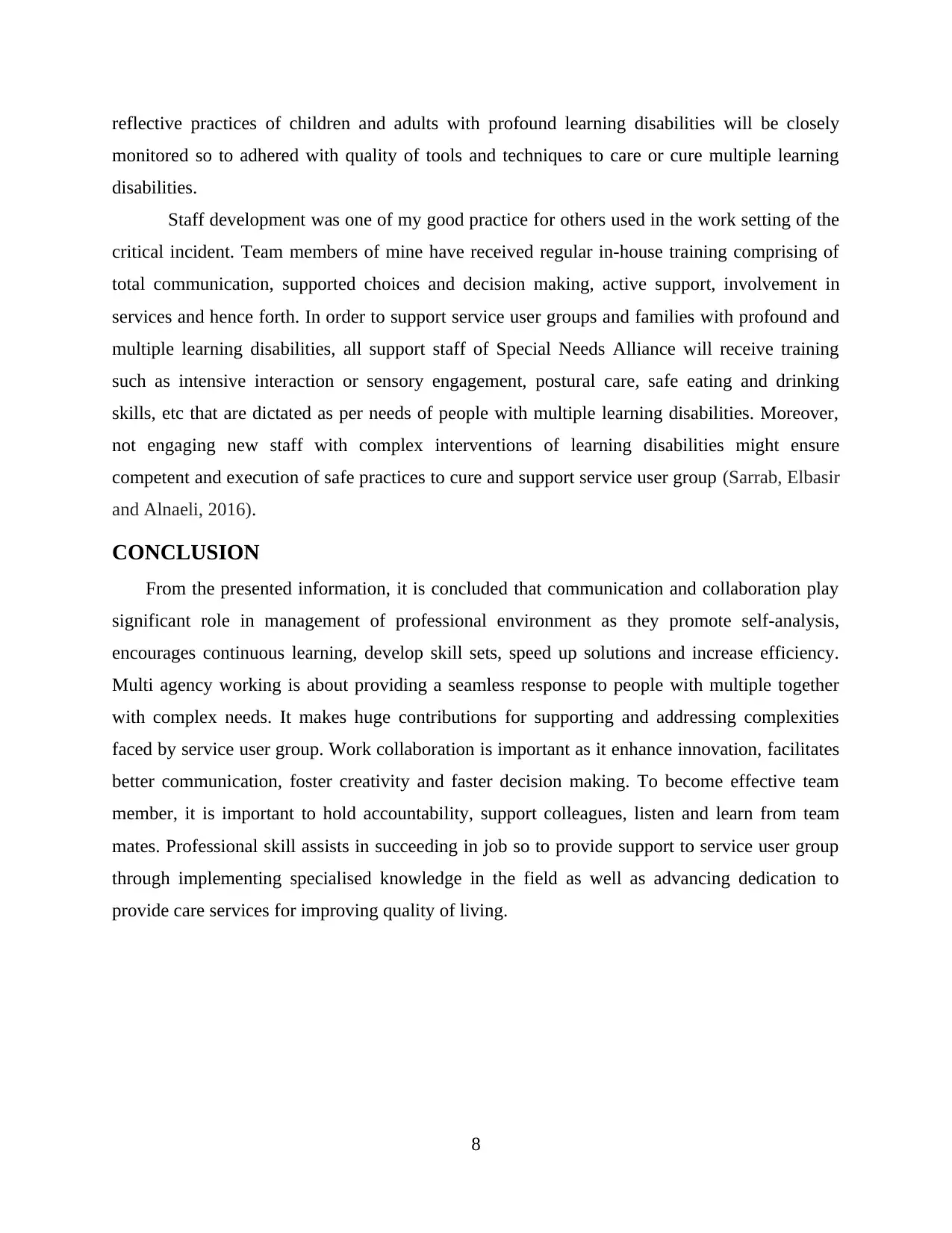
reflective practices of children and adults with profound learning disabilities will be closely
monitored so to adhered with quality of tools and techniques to care or cure multiple learning
disabilities.
Staff development was one of my good practice for others used in the work setting of the
critical incident. Team members of mine have received regular in-house training comprising of
total communication, supported choices and decision making, active support, involvement in
services and hence forth. In order to support service user groups and families with profound and
multiple learning disabilities, all support staff of Special Needs Alliance will receive training
such as intensive interaction or sensory engagement, postural care, safe eating and drinking
skills, etc that are dictated as per needs of people with multiple learning disabilities. Moreover,
not engaging new staff with complex interventions of learning disabilities might ensure
competent and execution of safe practices to cure and support service user group (Sarrab, Elbasir
and Alnaeli, 2016).
CONCLUSION
From the presented information, it is concluded that communication and collaboration play
significant role in management of professional environment as they promote self-analysis,
encourages continuous learning, develop skill sets, speed up solutions and increase efficiency.
Multi agency working is about providing a seamless response to people with multiple together
with complex needs. It makes huge contributions for supporting and addressing complexities
faced by service user group. Work collaboration is important as it enhance innovation, facilitates
better communication, foster creativity and faster decision making. To become effective team
member, it is important to hold accountability, support colleagues, listen and learn from team
mates. Professional skill assists in succeeding in job so to provide support to service user group
through implementing specialised knowledge in the field as well as advancing dedication to
provide care services for improving quality of living.
8
monitored so to adhered with quality of tools and techniques to care or cure multiple learning
disabilities.
Staff development was one of my good practice for others used in the work setting of the
critical incident. Team members of mine have received regular in-house training comprising of
total communication, supported choices and decision making, active support, involvement in
services and hence forth. In order to support service user groups and families with profound and
multiple learning disabilities, all support staff of Special Needs Alliance will receive training
such as intensive interaction or sensory engagement, postural care, safe eating and drinking
skills, etc that are dictated as per needs of people with multiple learning disabilities. Moreover,
not engaging new staff with complex interventions of learning disabilities might ensure
competent and execution of safe practices to cure and support service user group (Sarrab, Elbasir
and Alnaeli, 2016).
CONCLUSION
From the presented information, it is concluded that communication and collaboration play
significant role in management of professional environment as they promote self-analysis,
encourages continuous learning, develop skill sets, speed up solutions and increase efficiency.
Multi agency working is about providing a seamless response to people with multiple together
with complex needs. It makes huge contributions for supporting and addressing complexities
faced by service user group. Work collaboration is important as it enhance innovation, facilitates
better communication, foster creativity and faster decision making. To become effective team
member, it is important to hold accountability, support colleagues, listen and learn from team
mates. Professional skill assists in succeeding in job so to provide support to service user group
through implementing specialised knowledge in the field as well as advancing dedication to
provide care services for improving quality of living.
8
Paraphrase This Document
Need a fresh take? Get an instant paraphrase of this document with our AI Paraphraser
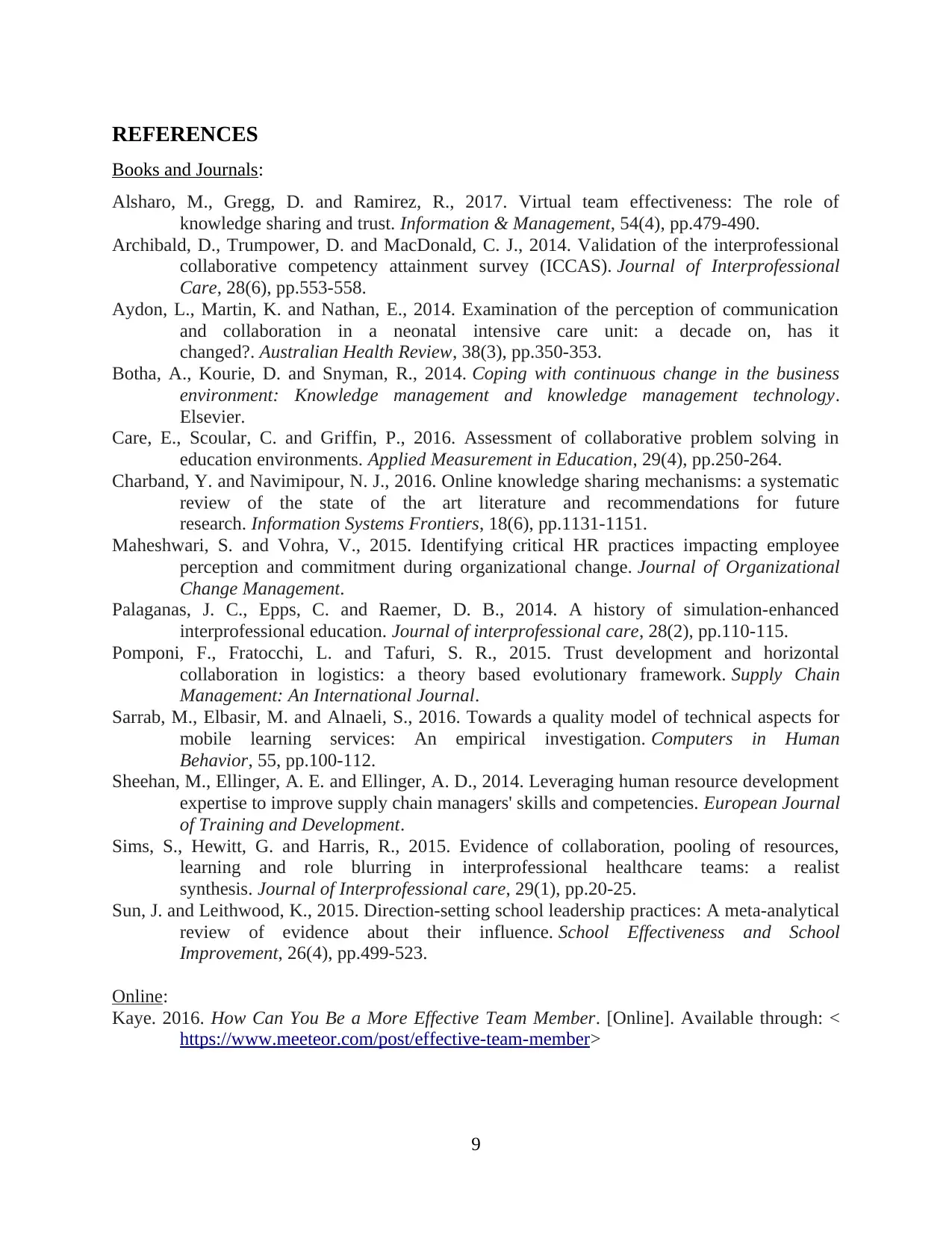
REFERENCES
Books and Journals:
Alsharo, M., Gregg, D. and Ramirez, R., 2017. Virtual team effectiveness: The role of
knowledge sharing and trust. Information & Management, 54(4), pp.479-490.
Archibald, D., Trumpower, D. and MacDonald, C. J., 2014. Validation of the interprofessional
collaborative competency attainment survey (ICCAS). Journal of Interprofessional
Care, 28(6), pp.553-558.
Aydon, L., Martin, K. and Nathan, E., 2014. Examination of the perception of communication
and collaboration in a neonatal intensive care unit: a decade on, has it
changed?. Australian Health Review, 38(3), pp.350-353.
Botha, A., Kourie, D. and Snyman, R., 2014. Coping with continuous change in the business
environment: Knowledge management and knowledge management technology.
Elsevier.
Care, E., Scoular, C. and Griffin, P., 2016. Assessment of collaborative problem solving in
education environments. Applied Measurement in Education, 29(4), pp.250-264.
Charband, Y. and Navimipour, N. J., 2016. Online knowledge sharing mechanisms: a systematic
review of the state of the art literature and recommendations for future
research. Information Systems Frontiers, 18(6), pp.1131-1151.
Maheshwari, S. and Vohra, V., 2015. Identifying critical HR practices impacting employee
perception and commitment during organizational change. Journal of Organizational
Change Management.
Palaganas, J. C., Epps, C. and Raemer, D. B., 2014. A history of simulation-enhanced
interprofessional education. Journal of interprofessional care, 28(2), pp.110-115.
Pomponi, F., Fratocchi, L. and Tafuri, S. R., 2015. Trust development and horizontal
collaboration in logistics: a theory based evolutionary framework. Supply Chain
Management: An International Journal.
Sarrab, M., Elbasir, M. and Alnaeli, S., 2016. Towards a quality model of technical aspects for
mobile learning services: An empirical investigation. Computers in Human
Behavior, 55, pp.100-112.
Sheehan, M., Ellinger, A. E. and Ellinger, A. D., 2014. Leveraging human resource development
expertise to improve supply chain managers' skills and competencies. European Journal
of Training and Development.
Sims, S., Hewitt, G. and Harris, R., 2015. Evidence of collaboration, pooling of resources,
learning and role blurring in interprofessional healthcare teams: a realist
synthesis. Journal of Interprofessional care, 29(1), pp.20-25.
Sun, J. and Leithwood, K., 2015. Direction-setting school leadership practices: A meta-analytical
review of evidence about their influence. School Effectiveness and School
Improvement, 26(4), pp.499-523.
Online:
Kaye. 2016. How Can You Be a More Effective Team Member. [Online]. Available through: <
https://www.meeteor.com/post/effective-team-member>
9
Books and Journals:
Alsharo, M., Gregg, D. and Ramirez, R., 2017. Virtual team effectiveness: The role of
knowledge sharing and trust. Information & Management, 54(4), pp.479-490.
Archibald, D., Trumpower, D. and MacDonald, C. J., 2014. Validation of the interprofessional
collaborative competency attainment survey (ICCAS). Journal of Interprofessional
Care, 28(6), pp.553-558.
Aydon, L., Martin, K. and Nathan, E., 2014. Examination of the perception of communication
and collaboration in a neonatal intensive care unit: a decade on, has it
changed?. Australian Health Review, 38(3), pp.350-353.
Botha, A., Kourie, D. and Snyman, R., 2014. Coping with continuous change in the business
environment: Knowledge management and knowledge management technology.
Elsevier.
Care, E., Scoular, C. and Griffin, P., 2016. Assessment of collaborative problem solving in
education environments. Applied Measurement in Education, 29(4), pp.250-264.
Charband, Y. and Navimipour, N. J., 2016. Online knowledge sharing mechanisms: a systematic
review of the state of the art literature and recommendations for future
research. Information Systems Frontiers, 18(6), pp.1131-1151.
Maheshwari, S. and Vohra, V., 2015. Identifying critical HR practices impacting employee
perception and commitment during organizational change. Journal of Organizational
Change Management.
Palaganas, J. C., Epps, C. and Raemer, D. B., 2014. A history of simulation-enhanced
interprofessional education. Journal of interprofessional care, 28(2), pp.110-115.
Pomponi, F., Fratocchi, L. and Tafuri, S. R., 2015. Trust development and horizontal
collaboration in logistics: a theory based evolutionary framework. Supply Chain
Management: An International Journal.
Sarrab, M., Elbasir, M. and Alnaeli, S., 2016. Towards a quality model of technical aspects for
mobile learning services: An empirical investigation. Computers in Human
Behavior, 55, pp.100-112.
Sheehan, M., Ellinger, A. E. and Ellinger, A. D., 2014. Leveraging human resource development
expertise to improve supply chain managers' skills and competencies. European Journal
of Training and Development.
Sims, S., Hewitt, G. and Harris, R., 2015. Evidence of collaboration, pooling of resources,
learning and role blurring in interprofessional healthcare teams: a realist
synthesis. Journal of Interprofessional care, 29(1), pp.20-25.
Sun, J. and Leithwood, K., 2015. Direction-setting school leadership practices: A meta-analytical
review of evidence about their influence. School Effectiveness and School
Improvement, 26(4), pp.499-523.
Online:
Kaye. 2016. How Can You Be a More Effective Team Member. [Online]. Available through: <
https://www.meeteor.com/post/effective-team-member>
9
1 out of 11
Related Documents
Your All-in-One AI-Powered Toolkit for Academic Success.
+13062052269
info@desklib.com
Available 24*7 on WhatsApp / Email
![[object Object]](/_next/static/media/star-bottom.7253800d.svg)
Unlock your academic potential
Copyright © 2020–2025 A2Z Services. All Rights Reserved. Developed and managed by ZUCOL.




